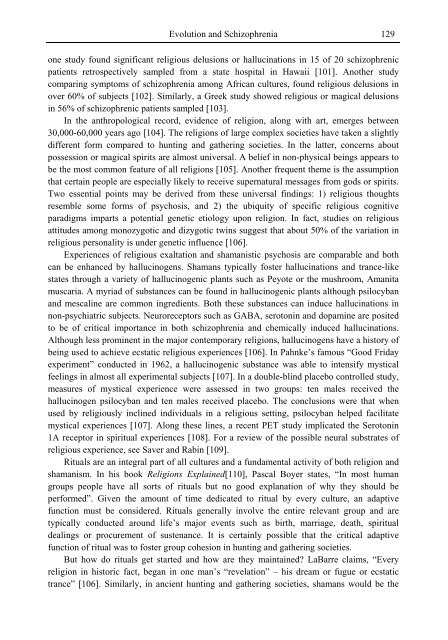Schizophrenia Research Trends
Schizophrenia Research Trends
Schizophrenia Research Trends
- No tags were found...
Create successful ePaper yourself
Turn your PDF publications into a flip-book with our unique Google optimized e-Paper software.
Evolution and <strong>Schizophrenia</strong> 129one study found significant religious delusions or hallucinations in 15 of 20 schizophrenicpatients retrospectively sampled from a state hospital in Hawaii [101]. Another studycomparing symptoms of schizophrenia among African cultures, found religious delusions inover 60% of subjects [102]. Similarly, a Greek study showed religious or magical delusionsin 56% of schizophrenic patients sampled [103].In the anthropological record, evidence of religion, along with art, emerges between30,000-60,000 years ago [104]. The religions of large complex societies have taken a slightlydifferent form compared to hunting and gathering societies. In the latter, concerns aboutpossession or magical spirits are almost universal. A belief in non-physical beings appears tobe the most common feature of all religions [105]. Another frequent theme is the assumptionthat certain people are especially likely to receive supernatural messages from gods or spirits.Two essential points may be derived from these universal findings: 1) religious thoughtsresemble some forms of psychosis, and 2) the ubiquity of specific religious cognitiveparadigms imparts a potential genetic etiology upon religion. In fact, studies on religiousattitudes among monozygotic and dizygotic twins suggest that about 50% of the variation inreligious personality is under genetic influence [106].Experiences of religious exaltation and shamanistic psychosis are comparable and bothcan be enhanced by hallucinogens. Shamans typically foster hallucinations and trance-likestates through a variety of hallucinogenic plants such as Peyote or the mushroom, Amanitamuscaria. A myriad of substances can be found in hallucinogenic plants although psilocybanand mescaline are common ingredients. Both these substances can induce hallucinations innon-psychiatric subjects. Neuroreceptors such as GABA, serotonin and dopamine are positedto be of critical importance in both schizophrenia and chemically induced hallucinations.Although less prominent in the major contemporary religions, hallucinogens have a history ofbeing used to achieve ecstatic religious experiences [106]. In Pahnke’s famous “Good Fridayexperiment” conducted in 1962, a hallucinogenic substance was able to intensify mysticalfeelings in almost all experimental subjects [107]. In a double-blind placebo controlled study,measures of mystical experience were assessed in two groups: ten males received thehallucinogen psilocyban and ten males received placebo. The conclusions were that whenused by religiously inclined individuals in a religious setting, psilocyban helped facilitatemystical experiences [107]. Along these lines, a recent PET study implicated the Serotonin1A receptor in spiritual experiences [108]. For a review of the possible neural substrates ofreligious experience, see Saver and Rabin [109].Rituals are an integral part of all cultures and a fundamental activity of both religion andshamanism. In his book Religions Explained[110], Pascal Boyer states, “In most humangroups people have all sorts of rituals but no good explanation of why they should beperformed”. Given the amount of time dedicated to ritual by every culture, an adaptivefunction must be considered. Rituals generally involve the entire relevant group and aretypically conducted around life’s major events such as birth, marriage, death, spiritualdealings or procurement of sustenance. It is certainly possible that the critical adaptivefunction of ritual was to foster group cohesion in hunting and gathering societies.But how do rituals get started and how are they maintained? LaBarre claims, “Everyreligion in historic fact, began in one man’s “revelation” – his dream or fugue or ecstatictrance” [106]. Similarly, in ancient hunting and gathering societies, shamans would be the
















